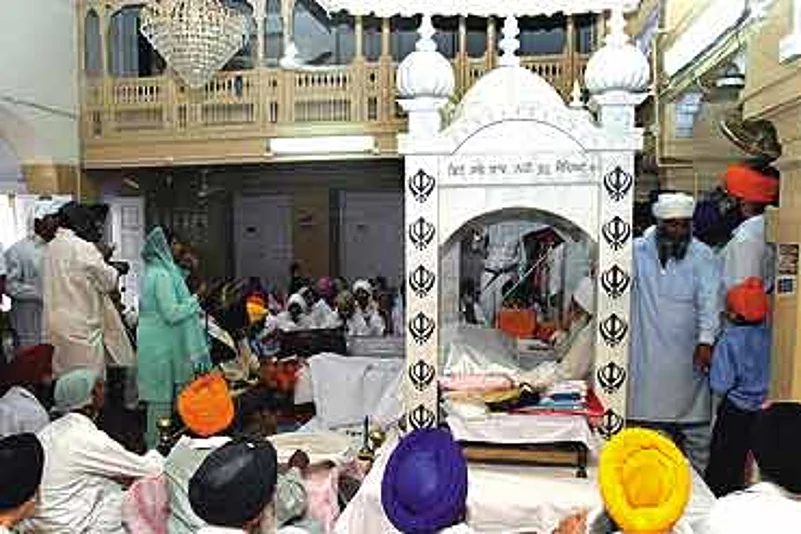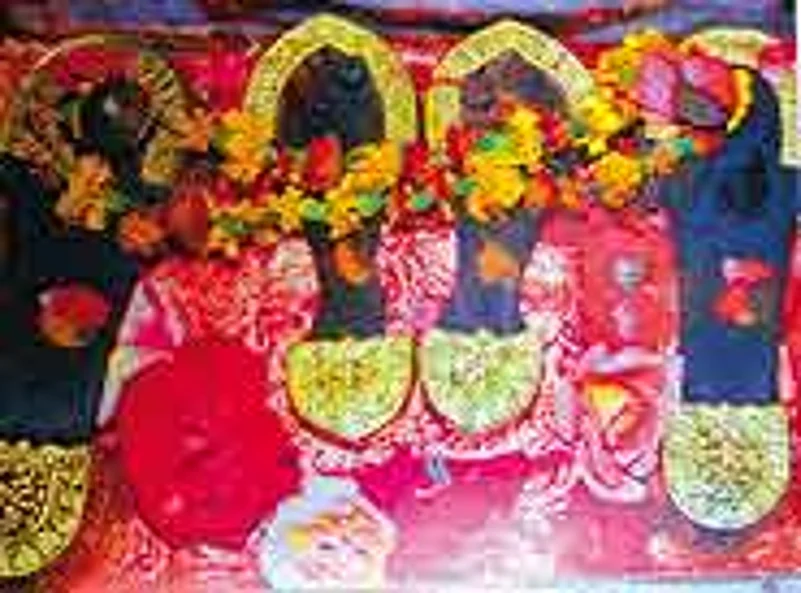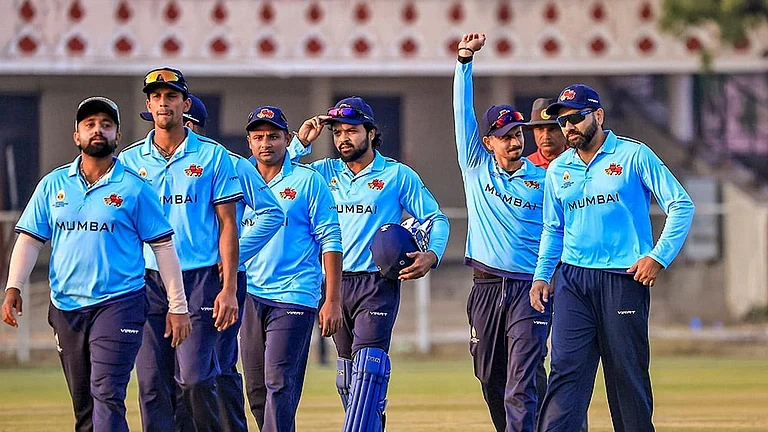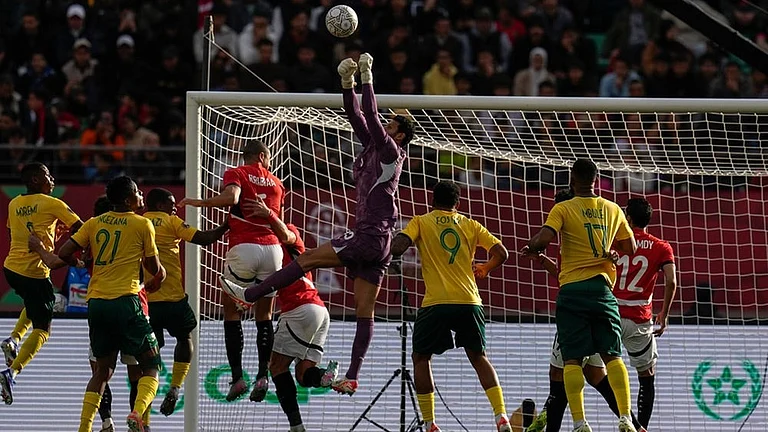A glittering gold palanquin, a maharaja in tow and crowds heaving with religious fervour. A scene out of the pages of a medieval history book? Nay. This is modern-day Punjab and the event is a finely-scripted exercise designed to anoint Punjab chief minister Amarinder Singh as the true leader of the Sikhs. The multitudes that turned out to greet the unique procession en route from Delhi to Lahore are enough to warm the cockles of any politician. In the Sikh world, which also includes the influential Sikh diaspora, though, there is outrage at what is being seen as a 'degradation' of the Sikh religion. Are the basic tenets of the faith taking a tumble at the altar of politics?
It all began with an anonymous donation of Rs 60 lakh to the Delhi Sikh Gurudwara Management Committee (DSGMC) a few months ago for a gold 'palki', which the donor (some say it's a liquor baron close to Amarinder Singh) wanted to instal at Nankana Sahib in Pakistan, the birthplace of the founder of Sikhism, Guru Nanak Dev. Enter Amarinder Singh, through the good offices of DSGMC president Paramjit Singh Sarna. Both have been working together for quite some time now to counter the Shiromani Akali Dal's control over Sikh religious affairs. So, it was decided that the new palki will be taken in a procession to Nankana Sahib, with Amarinder Singh accompanying it as a 'devout Sikh'. No eyebrow was raised here, for religion and politics go hand in hand in Punjab.
Sarna, however, announced rather ambitiously that the new palki will replace the original marble one which exists at the historic gurudwara. At this, Sikh organisations like the SGPC and some academics opposed the move. A furore built up over the proposed demolition of the small marble palki built during Maharaja Ranjit Singh's time in the 19th century. Many, including former chief election commissioner and now Rajya Sabha MP from Punjab M.S. Gill, likened the move to the demolition of several historic Sikh structures in Punjab in the last 30-odd years, to make way for shining new marble gurudwaras. The plan to demolish the old palki was hastily dropped and Amarinder announced publicly that he would not accompany the palki procession if it was to replace the original structure at Nankana Sahib. It was then decided that they would leave the matter of where to instal the new golden palki with the Pakistan Sikh Gurudwara Prabandhak Committee (PSGPC) which is looking after the shrine's upkeep.
The ornate palki, built at an ashram in Tarn Taran, has about 10 kg of gold on it. A gold photo frame with a picture of Guru Nanak Dev and his two disciples and a teak platform have also travelled with it. Amarinder's contribution to the effort was a set of ancient weapons gifted to his family by the 10th Sikh Guru, Gobind Singh. The weapons accompanied the procession till Wagah and were meant to remind the people of his family's links with the Sikh gurus. Accompanied by his entire cabinet, a bevy of journalists, and expensive gifts for Pakistani officials on the other side, the 1,800-strong procession crossed over to Pakistan on foot for what has been described as a 'historic event'. But back home, the brickbats are flying thick and fast.
Says noted Sikh writer Patwant Singh, "This veneration of a gold palki amounts to idol worship, which is an anathema in Sikhism. Sikhism was known for making a break with the past, shunning the decadent practices of ritualism and idol worship. This hullabaloo over a mere palki is out of sync with our faith. We seem to be going the way of other religions by allowing ostentation to creep in again. How does this improve the profile of the faith?"
Interestingly, the Sikh diaspora, which has built grand gurudwaras abroad, has also been quite vociferous in denouncing the golden palki Tarlochan Singh, chairman of the National Commission on Minorities, told Outlook, "Lots of Sikhs settled abroad have been writing to me to protest against this move. We Sikhs believe in the word of God and not in material things like a gold palki." Even earlier, it was the UK Sikhs association which had opposed the move to replace the marble palki at Nankana Sahib.
Though Amarinder and Sarna have abandoned their plan to replace the original palki and left its placement to the wisdom of the PSGPC, there is some unease. M.S. Gill, who first raised the issue, says, "The Nankana Sahib shrine belongs to Sikhs all over the world. It's like our Mecca. The small Sikh community of Pakistan cannot be allowed to take a unilateral decision on what is to be done with the palki at this holy shrine. And the PSGPC is not even in the hands of the small Sikh population there but is controlled by the generals of the Pakistan army. The person who has been made its president is meant to provide a token presence of a turbaned Sikh. It's not a simple thing of handing it over to the PSGPC as it is not representative of the millions of Sikhs all over the world."

The palki has also raised questions about the steady destruction of Sikh historical monuments in Punjab in the last 30-odd years. Though Amarinder Singh has himself been critical of the SGPC-sponsored demolition of several historical monuments in Punjab, which have been replaced mostly by opulent marble gurudwaras built by 'kar sewa babas', many say that what he has done now is not very different. Sikh scholars say the lavish use of marble and gilding in the new structures is dictated by a desire for ostentatious display of wealth, with little thought about the historical sanctity of the original relics and structures. For example, at the Patna Sahib Gurudwara, points out Gurcharanjit Singh Lamba, editor of the community journal, Sant Sipahi, "Someone put gold on two khadaon, one made of ivory belonging to Guru Gobind Singh and other of sandalwood belonging to Guru Teg Bahadur. And now this gold palki."

Ironically, Sikh shrines in Pakistan are relatively better preserved in their original form, mainly because there were no overzealous, cash-rich community leaders out there to 'beautify' them. But as Tarlochan Singh points out, "With the clamour for more control over Sikh shrines in Pakistan, and their upkeep, it's only a matter of time that they too will be 'beautified in gold'. Although the move to replace the original palki has thankfully been abandoned, this only underlines the danger to the structures there."
The politics behind the event have not been missed by anyone. Even in their wildest dreams, Sarna and Amarinder perhaps never expected such a huge turnout wherever the 'palki sahib' passed through Haryana and Punjab before entering Pakistan at Wagah. Spontaneous langars and chabeels (roadside stalls offering water and sherbet) sprouted at umpteen places along the route for the 1,000-vehicle strong procession. As an exercise aimed at wooing the hearts of Sikh peasants in the run-up to the assembly elections due in Punjab in one year, the palki procession appears to be a thumping success. Never mind if, in the process, Amarinder Singh flouts the teachings of the Sikh gurus, who preach simplicity and lack of ostentation in life and worship.


























